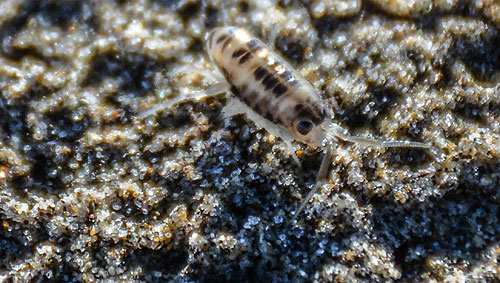Gobs of Cool Creatures, Odd Finds on Oregon Coast Beaches Now
Published 10/26/2016 at 5:11 AM PDT
By Oregon Coast Beach Connection staff

(Seaside, Oregon) – A brief walk along any Oregon coast beach can yield bundles of wonders, especially after storms. This past weekend – less than a week since some of the big winds and waves – Seaside Aquarium's Tiffany Boothe wandered that stretch in front of the nearly 80-year-old attraction to make some interesting finds of stuff just lying around. This included a few critters that were curiously out of place and of a Halloween theme. (All photos Tiffany Boothe, Seaside Aquarium).
One of the highlights of her walk was finding a salp or two (above). These look like jellyfish and are indeed related – but not quite in that category.
“In order to understand the salp you must first understand the tunicate,” Boothe said. “Tunicates belong to the same phylum as vertebrates. Though as adults they do not have a backbone, developing larvae posses a tail, a dorsal nerve cord, and a dorsal stiffening structure (not composed of bone) called the notochord. Because of this, tunicates are thought to be more closely related to vertebrates such as fish and people.”
A salp is what is known as a pelagic tunicate, meaning they drift along the waters of the ocean, including the Oregon coast.
“They move by means of jet propulsion, and feeding is accomplished by pumping plankton-laden water through the body where a mucous net is used to extract food particles,” Boothe said. “They can be found individually or in large aggregations consisting of millions of individuals.”

Another striking find was the sheer masses of tube worm casings. Tube worms – mostly called cellophane worms – live in the deeper waters. They live inside these protective casings, which are actually first secreted by their own bodies and then harden into a shell that keeps them from harm.
If the right kind of ocean upwelling, storm and currents come together, gobs of them wash up onshore. Boothe said lots of them have been coming ashore in recent weeks. (Earlier this year, these caused a stir on the central coast).

Then there was that amphipod Boothe found. These are tiny shrimp-like crustaceans.
“This is probably the cutest amphipod in the world,” Boothe said. “The Hitchhiking amphipod takes refuge inside of jellyfish. This poor little guy must have lost his jelly.”

Also considered cute by Boothe: the Pale Beach Hopper.
These are the most common kind of sand flea you'll find on the Oregon coast. Although they are not fleas at all but amphipods, just like the previous creature she raved about.
When the Pale Beach Hopper notices you approaching, it lives up to its name and hops away in a flash. It does so by flexing and straightening its body. Also unlike fleas: they do not bite. Indeed, they're an important part of the ecosystem as they eat marine debris that has washed up. They help keep the beaches clean.

Among the more curious finds, however, were a few spiders and an insect related to the potato bug.
“Wow, is that four now?” Boothe said. “I guess someone has to make all that webbing for Halloween.” Oregon Coast Hotels when beachcombing - Where to eat - Maps - Virtual Tours


More About Oregon Coast hotels, lodging.....
More About Oregon Coast Restaurants, Dining.....
Cannon Beach Lodging
Nehalem Bay Lodgings
Manzanita Hotels, Lodging
Three Capes Lodging
Pacific City Hotels, Lodging
Lincoln City Lodging
Depoe Bay Lodging
Newport Lodging
Waldport Lodging
Yachats Lodging
Oregon Coast Vacation Rentals
Oregon Coast Lodging Specials
LATEST Related Oregon Coast Articles
No major storms so likley no massive waves
Astoria's Pigeon Steps a Quirky but Scenic Walk of Oregon Coast History
Paved walkways with curious strips, charming but awkward. Astoria history
Update on S. Oregon Coast Closures at Sunset Bay Campground, Shore Acres
What's opening near Coos Bay and what isn't yet: travel, hiking advice. Coos Bay, Charleston
Commercial Dungeness Crab Opens on N. Oregon Coast, Washington
The fishery opens Jan. 15 from Cape Falcon to Klitsap Beach. Marine sciences
Oregon Coast Winter Chills the Rates at Lincoln City, Cannon Beach
This time of year cheaper but some dive down even farther. Cannon Beach hotel specials, Lincoln City hotel specials
Indistinct Oregon Coast Day Turns Into Surreal, Intense Colors At Lincoln Cit...
From blue waves to wild shades at dusk and overnight
N. Oregon Coast's Astoria Riverwalk Trail Getting Lighting
About ten blocks of the trail will get new lights
Old, Familiar Oregon Coast Landmark Tree Falls Off Garibaldi's Three Graces
There for a good 150 years, toppled by a windstorm. Tillamook Bay, Rockaway Beach, Oceanside, Cape Meares
Back to Oregon Coast
Contact Advertise on BeachConnection.net
All Content, unless otherwise attributed, copyright BeachConnection.net Unauthorized use or publication is not permitted













































